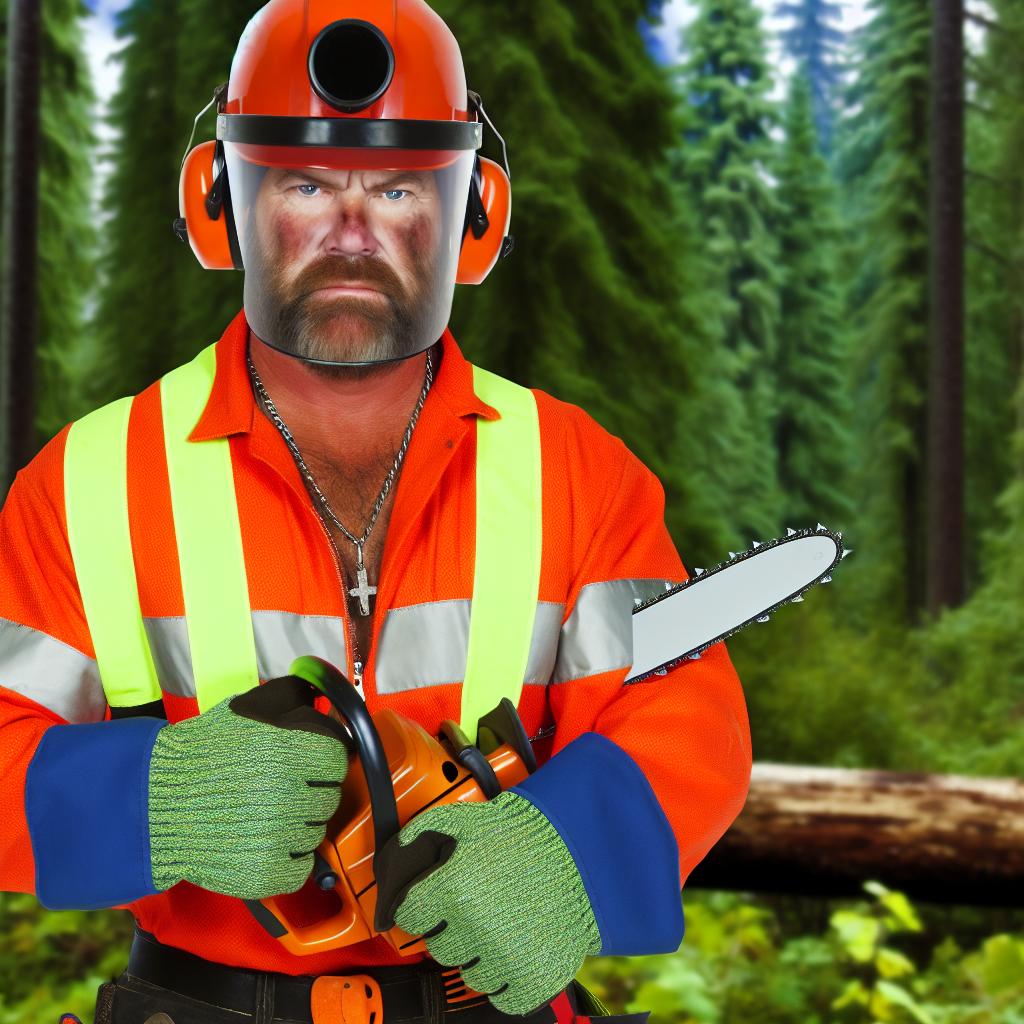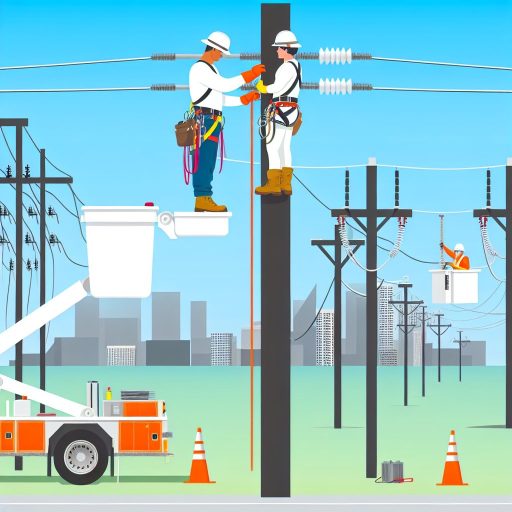Introduction:
It is crucial for lumberjacks to prioritize safety gear while on the job.
Logging is inherently perilous, with risks ranging from falling trees to sharp tools.
Equipping oneself with the proper safety equipment can significantly reduce the likelihood of accidents and injuries.
Head Protection:
Hard hats are essential for safeguarding lumberjacks’ heads from falling branches or debris.
Eye and Face Protection:
Goggles or face shields shield the eyes and face from wood chips and sawdust.
Hearing Protection:
Ear muffs or earplugs can prevent hearing damage caused by loud chainsaws and machinery.
Hand Protection:
Gloves provide protection against cuts, blisters, and splinters while handling equipment.
Leg Protection:
Chainsaw chaps are crucial for preventing severe leg injuries in case of accidental contact.
Foot Protection:
Steel-toed boots offer protection from heavy objects and sharp tools that may fall.
Respiratory Protection:
Respirators filter out harmful dust and fumes that lumberjacks may inhale while working.
High-Visibility Clothing:
Wearing bright, reflective clothing ensures lumberjacks are visible in dense forests and low-light conditions.
Importance of Safety Gear:
Investing in proper safety gear is a non-negotiable aspect of a lumberjack’s job.
By prioritizing safety equipment, lumberjacks can protect themselves from the inherent dangers of logging.
This approach ensures a long, healthy career in the industry.
Hard Hat:
It’s crucial to shield the head from falling objects during lumberjack work.
There are various types of hard hats available, such as ANSI-rated helmets.
Always ensure that your hard hat fits properly to maximize protection.
Regular maintenance of your hard hat is essential for its effectiveness.
Eye Protection:
Safeguarding your eyes from debris and wood chips is extremely important.
Safety glasses or goggles should be worn at all times during work.
Transform Your Career Today
Unlock a personalized career strategy that drives real results. Get tailored advice and a roadmap designed just for you.
Start NowMake sure your eye protection is ANSI-approved for quality assurance.
Replace any damaged or scratched eye protection to maintain clear visibility.
Ear Protection:
Long-term exposure to chainsaws and heavy machinery can damage hearing.
Using earplugs or earmuffs can help reduce the risk of hearing loss.
Ensure your ear protection has the appropriate Noise Reduction Rating (NRR).
Regularly clean and replace ear protection to maintain effectiveness.
Gloves:
Protecting your hands from splinters, cuts, and abrasions is vital.
Choose gloves with good grip and durability for handling tools and wood.
Leather or Kevlar gloves are ideal for lumberjack work due to their toughness.
Replace gloves if they become worn out or damaged to maintain protection.
Chainsaw Chaps:
Preventing chainsaw accidents is a top priority in lumberjack safety.
Chainsaw chaps offer leg protection against accidental cuts and injuries.
Look for chaps with multiple layers of Kevlar for maximum protection.
Regularly inspect and replace chainsaw chaps if they show signs of wear.
Steel-Toed Boots:
Protecting your feet from falling objects and sharp debris is essential.
Steel-toed boots provide added safety in case of heavy objects landing on your feet.
Ensure your boots fit well and are comfortable for long hours of work.
Regularly check for any signs of wear or damage to your steel-toed boots.
High-Visibility Clothing:
Being visible to others in the work environment is crucial for safety.
Showcase Your Business Today
Reach thousands of readers actively exploring professional services. Publish your business profile and grow your audience now.
Publish NowWear brightly colored clothing or high-visibility vests during lumberjack work.
High-visibility apparel helps prevent accidents by making you easily noticeable.
Regularly wash and inspect your high-visibility clothing for any wear or tear.
Eye Protection:
When it comes to lumberjack safety gear, eye protection is a crucial aspect that should not be overlooked.
Here are some key points to consider:
Risks to eyes from flying debris:
- One of the main hazards faced by lumberjacks is the risk of flying debris.
- Sharp wood chips, branches, and other objects can cause serious injuries to the eyes.
- Without proper eye protection, lumberjacks are susceptible to eye damage or even blindness.
Different types of safety glasses and goggles:
- There are various options available for eye protection, including safety glasses and goggles.
- Safety glasses are suitable for general tasks, while goggles provide better coverage and protection.
- It is essential to choose the right type of eye protection based on the specific job requirements.
Importance of clear vision for safe operation:
- Clear vision is vital for safe and efficient operation in lumberjack tasks.
- Obstructed vision due to debris or dust can lead to accidents and injuries.
- Proper eye protection ensures that lumberjacks can see clearly and perform their tasks with precision.
Eye protection should be a top priority for all lumberjacks to prevent injuries and ensure a safe working environment.
Uncover the Details: Understanding Sheet Metal Worker Union Benefits
Ear Protection:
Working as a lumberjack exposes you to various hazards.
This includes the danger of prolonged exposure to loud noise.
Dangers of Prolonged Exposure to Loud Noise:
- Hearing loss
- Tinnitus
- Increased stress levels
These risks make it crucial to invest in proper ear protection while on the job.
Options for Ear Protection:
- Earmuffs: These cover the ears completely and are effective in blocking out noise.
- Earplugs: These are small devices that fit into the ear canal to reduce noise levels.
- Electronic ear protection: Provides noise reduction while allowing you to hear important sounds.
Choose the option that best suits your needs and ensures maximum protection.
How to Properly Wear and Maintain Ear Protection:
- Ensure a proper fit for maximum protection.
- Clean your ear protection regularly to prevent dirt buildup.
- Inspect your ear protection for any signs of wear and tear.
- Replace ear protection as needed to guarantee effectiveness.
By following these guidelines, you can ensure your ear protection remains in top condition.
This provides the necessary safety measures while working as a lumberjack.
Gain More Insights: Understanding Tile Layout Patterns for Stunning Designs
Safety as a Lumberjack Priority
When it comes to working as a lumberjack, safety should always be a top priority.
Part of ensuring safety on the job is having the right gear, including gloves.
Gloves are essential for protecting your hands from cuts, blisters, and splinters that can occur while handling lumber.
Types of Gloves
- Choose gloves made from different materials based on the task at hand, such as leather or Kevlar.
Leather gloves are durable and offer good protection against cuts and splinters, making them ideal for general handling of lumber.
On the other hand, Kevlar gloves provide excellent cut resistance, which is perfect for tasks that involve using sharp tools like chainsaws.
Choosing the Right Size
- Make sure to select gloves that fit properly to ensure maximum protection and dexterity.
Gloves that are too loose may slip off while you work, increasing the risk of accidents.
Conversely, gloves that are too tight can restrict movement and reduce dexterity, making it difficult to handle tools effectively.
To find the right size, measure your hand and refer to the manufacturer’s sizing chart.
Investing in a good pair of gloves is a small price to pay for the protection and comfort they provide.
Remember, when it comes to safety, it’s always better to be over-prepared than underprepared.
So, don’t overlook the importance of wearing gloves as part of your lumberjack safety gear.
Delve into the Subject: How to Become a Boilermaker: Step-by-Step Guide
Footwear:
When it comes to lumberjack safety gear, choosing the right footwear is crucial for a safe and productive work environment.
Here are some key points to consider:
Importance of sturdy boots with ankle support
- Sturdy boots provide stability and support while navigating rough terrain.
- Ankle support helps prevent twisting or rolling during heavy lifting or climbing.
- Protects the delicate ankle bones from injury in case of a fall or accident.
Protection from sharp objects and chainsaw cuts
- Thick, durable boots act as a barrier against sharp branches, rocks, and debris.
- Boots with reinforced toe caps can protect against accidental chainsaw contact.
- Reduce the risk of injury from accidental slips or falls while operating machinery.
Features to look for in lumberjack boots (e.g. steel toe, waterproofing)
- Steel toe boots provide an extra layer of protection against heavy equipment.
- Waterproof boots keep feet dry and comfortable in wet or snowy conditions.
- Grippy soles offer traction on slippery surfaces, reducing the risk of falls.
Investing in high-quality, safety-rated boots is essential for any lumberjack looking to stay safe and comfortable on the job.
Remember, when it comes to safety gear, it’s better to be over-prepared than under-protected.
Discover More: Innovative Trends in Landscape Architecture 2025

Chainsaw Chaps
Chainsaw chaps offer specific protection against chainsaw accidents by providing an extra layer of defense for the legs.
How chainsaw chaps work to prevent severe injuries
- Chainsaw chaps are made of durable material that can withstand the impact of a chainsaw blade.
- When a chainsaw blade comes in contact with the chaps, the fibers jam the chain and halt the blade’s rotation.
- This action prevents the blade from cutting through the fabric and into the wearer’s leg.
- Chainsaw chaps are designed to reduce the risk of severe lacerations and amputations in the event of an accident.
Proper care and maintenance of chainsaw chaps
- Regularly inspect chainsaw chaps for any signs of wear, damage, or deterioration.
- Ensure that the chaps are properly fitted to the wearer to maximize protection.
- Follow the manufacturer’s guidelines for cleaning and storing chainsaw chaps.
- Replace chainsaw chaps if they become damaged or compromised in any way.
By wearing chainsaw chaps and taking proper care of them, lumberjacks can significantly reduce the risk of serious injury while on the job.
Respiratory Protection:
– Inhaling sawdust and pollutants is hazardous to lumberjacks’ health.
– Different types of respirators offer varying levels of protection.
– Proper fit testing and usage are essential for respiratory protection.
Respiratory protection is crucial for lumberjacks working in environments where sawdust, chemicals, and other pollutants may be present.
Inhaling these particles can lead to serious respiratory issues and long-term health complications.
Therefore, it is imperative for lumberjacks to understand the importance of using respiratory protection and the different options available to them.
Dangers of Inhaling Sawdust and Other Pollutants:
Sawdust, when inhaled, can cause respiratory irritation, coughing, and even long-term lung damage.
Showcase Your Business Today
Reach thousands of readers actively exploring professional services. Publish your business profile and grow your audience now.
Publish NowAdditionally, certain chemicals used in the logging industry can be harmful if inhaled.
Without proper respiratory protection, lumberjacks are at risk of developing serious health conditions.
Types of Respirators for Different Levels of Protection:
There are several types of respirators that offer different levels of protection against sawdust and pollutants.
The most common types used by lumberjacks include:
- Disposable Dust Masks: These are lightweight masks that provide basic protection against larger particles, such as sawdust. They are suitable for light-duty tasks.
- Half-Face Respirators: These respirators cover the nose and mouth and offer better protection against smaller particles and chemicals. They are ideal for more hazardous work environments.
- Full-Face Respirators: Providing the highest level of protection, full-face respirators cover the entire face and offer protection against both particulates and chemicals. They are recommended for high-risk tasks.
Fit Testing and Proper Use of Respiratory Protection:
It is essential for lumberjacks to undergo fit testing for their respirators to ensure a proper seal and maximum protection.
An ill-fitting respirator can allow particles to enter, defeating the purpose of wearing it.
Furthermore, lumberjacks should be trained on how to properly wear, remove, and maintain their respirators.
Regular inspection and cleaning of respirators are necessary to ensure their effectiveness and longevity.
By understanding the dangers of inhaling sawdust and pollutants, selecting the right type of respirator for the job, undergoing fit testing, and using the equipment properly, lumberjacks can effectively protect their respiratory health while on the job.
Safety Gear for Lumberjacks
Lumberjacks must prioritize their safety by investing in essential safety gear.
Quality equipment enhances productivity and ensures worker well-being.
Regular safety training is essential in preventing accidents and injuries.
Gear inspections should be conducted routinely.
By emphasizing the importance of safety, lumberjacks can work confidently.
They can handle challenges knowing they are well-equipped.
Additional Resources
1910 | OSHA.gov | Occupational Safety and Health Administration




